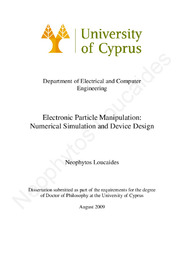Electronic particle manipulation : numerical simulation and device design
Date
2009-09Author
Loucaides, NeophytosPublisher
Πανεπιστήμιο Κύπρου, Πολυτεχνική Σχολή / University of Cyprus, Faculty of EngineeringPlace of publication
CyprusGoogle Scholar check
Keyword(s):
Metadata
Show full item recordAbstract
Αυτή η Διατριβή ασχολείται με την προσομοίωση συσκευών οι οποίες χρησιμοποιούν τεχνικές Ηλεκτροκινητικής Εναλλασσόμενου Ρεύματος (ΗΕΡ) για τη διαχείριση μικρο- και νανο-σωματιδίων. Οι προσομοιώσεις αυτές είναι αναγκαίες για την καλύτερη κατανόηση και το σχεδιασμό συσκευών ΗΕΡ οι οποίες συμπεριφέρονται με πιο προβλεπτό τρόπο. Βασικό βήμα προς την κατεύθυνση αυτή είναι η ανάπτυξη ενός φυσικού μοντέλου το οποίο να περιγράφει τη δυναμική τέτοιων συσκευών. Χρησιμοποιώντας το φυσικό μοντέλο, παρουσιάζονται αριθμητικές προσομοιώσεις της λειτουργίας των συσκευών. Οι προσομοιώσεις μπορούν να χρησιμοποιηθούν για να βοηθήσουν στην ανάλυση των συσκευών και σαν μια γρήγορη και χαμηλού κόστους μέθοδος για τον σχεδιασμό καινοτόμων συσκευών.
Τα αποτελέσματα από την προσομοίωση μιας πραγματικής συσκευής για διαχείριση DNA συγκρίνονται επίσης με πειραματικά αποτελέσματα και επιδεικνύουν πιο ρεαλιστική συμπεριφορά από το προηγούμενο μοντέλο. Επίσης, η δυνατότητα επανάληψης της προσομοίωσης χωρίς ΗΚΕΡ επιτρέπει την επεξήγηση παρατηρήσεων οι οποίες δεν μπορούσαν να εξηγηθούν προηγουμένως, όπως η μή γραμμική σχέση του αρχικού ρυθμού αύξησης της συγκέντρωσης σωματιδίων σε σχέση με την διπολική ροπή τους. Επίσης, ακόμα πιο ενδιαφέρον είναι το γεγονός ότι από τις προσομοιώσεις μπορεί να εξαχθεί ότι η μή γραμμική σχέση οφείλεται σε ενίσχυση της διαδικασίας.
Το τροποποιημένο μοντέλο επιτρέπει επίσης τη διερεύνηση πολλών μεταβλητών σχεδιασμού, όπως το μέγεθος των σωματιδίων και το ύψος των ηλεκτροδίων. Έτσι, η συμπεριφορά των συσκευών σε σχέση με διάφορες παραμέτρους σχεδιασμού μπορεί να διερευνηθεί με πολύ χαμηλό κόστος και σε πολύ λίγο χρόνο σε σύγκριση με αυτόν που απαιτείται με πειραματικές μεθόδους. This thesis deals with the simulation of devices utilising AC Electrokinetics (ACEK) for the manipulation of micro- and nano-particles. Such simulations are necessary in order to better understand and design AC Electrokinetics devices that behave in a more predictable manner. A fundamental step towards the better understanding of ACEK methods is the development of a physical model that can describe the dynamics of such devices. Using such a physical model, numerical simulations of the devices' operation are performed.
The results from the simulation of a real device for DNA manipulation are then compared with available experimental data and exhibit a more realistic behaviour than the previous model. Also, the ability to extract data from the simulation with and without the inclusion of the ACEO fluid motion allows the interpretation of observations previously unexplained, such as the non-linearity of the initial rate of increase of the particle collection with the particle polarisability. What is even more important in the results produced is that it can be deduced that the non-linearity of the relationship is actually due to enhancement of the initial rate of increase of the particle collection.
The modified model also allows the investigation of many design parameters that are important for the device operation, such as the particle size and the electrode height. The behaviour of devices with a range of different characteristics can therefore be investigated using simulations that can be performed with a relatively much lower cost and at reduced computation time compared to purely experimental methods.

